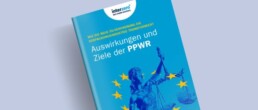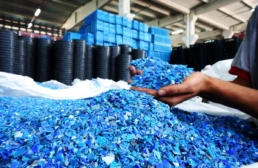The EU Packaging Regulation PPWR
(“Packaging, Packaging Waste Regulation”)
How to prepare for the transformation of the packaging industry through PPWR
The EU Packaging and PackagingWaste Regulation(PPWR) aims to reduce the negative impact of packaging on the environment more effectively. The aim is to ensure that packaging is minimized, the sustainability of packaging is improved and packaging waste is reduced. These regulations are to be harmonized and applied in all EU member states.
The facts and milestones of the Packaging & Packaging Waste Regulation (PPWR)
The EU Packaging Regulation replaces the current European Directive on Packaging and Packaging Waste, which has been in force since 1994. It includes waste reduction targets, the extension of extended producer responsibility (“EPR”) and requirements for the recyclability of Packaging, in particular by promoting the use of recyclates.
The most important milestones of the PPWR are:
2022 Publication of PPWR draft: The draft of the EU packaging regulation PPWR is published by the European Commission and sets out concrete targets for reducing packaging waste and requirements for packaging.
2024 Approval in the trilogue procedure: EU Parliament and Council of the European Union approve the regulation. As soon as the legal act is finalized and becomes effective, the EU Packaging Regulation takes immediate effect at EU level. (Despite national laws)
2025 Entry into force of the regulation: 20 days after publication in the Official Journal of the EU (January 22, 2025), the PPWR will enter into force
2026 Legally binding: 18 months after entry into force, the PPWR will become legally binding in August 2026
2030 Quotas for minimum recyclate use: Recyclate quotas, which currently only apply to single-use beverage bottles, are to be extended to all types of packaging. The minimum proportion of PCR can lead to bottlenecks. (Read our white paper)
What you can expect here:
- The most important facts about the PPWR
- PPWR – significance for companies
- Effects and objectives of the PPWR
- Recycled plastics and PCR (post-consumer recycled material)
- PCR Gap: Strategies against PCR shortage
- Packaging analysis “Recyclability of packaging”
- Clear measures through packaging optimization
- EPR compliance through “packaging licensing”
PPWR: What you need to be aware of due to the European Packaging Ordinance
Stricter requirements. Harmonized standards. Strategic changes for manufacturers and retailers. Packaging adjustments. A new era is being ushered in, because Packaging & Packaging Waste requires companies to fundamentally rethink their approach.
Conformity & documentation: Every type of packaging must undergo a conformity assessment procedure. Manufacturers must prepare technical documentation, as only correctly labeled, PPWR-compliant packaging may be placed on the market.
Packaging reduction & efficiency: Stricter limits on empty space, weight and size for packaging are intended to reduce unnecessary packaging waste.
Minimum recyclate quotas: How much recyclate must be used for certain plastic packaging is prescribed. Retailers may only use packaging that meets these minimum quotas.
Transparent labeling: Uniform icons and information on material composition should make it easier for consumers to separate waste. There is a clear information obligation for manufacturers and importers.
Reusability: Reusable packaging is defined by binding criteria. These must also be verified.
Recyclability & packaging design (circular design): Packaging must be designed to be recyclable at end of life. Non-recyclable packaging will be banned in the EU from 2030.
Effects and objectives of the PPWR

Interzero supports companies in the transformation necessary to implement the obligations of the PPWR in a timely manner. Read our white paper to learn more about the objectives and impacts of the PPWR , information on financial incentive models “ecomodulation” and extended producer responsibility .
Act now and take the initiative!
Request a white paper on the PPWR now
Recycled plastics and PCR (post-consumer recycled material)
Recycled plastics are made from used plastic waste, which is sorted, cleaned and processed into new pellets. Interzero operates several state-of-the-art plants that transform plastics such as PE, PP, PET or EPS into consistently high-quality pellets – the basis for new products in industry and trade.
As one of the leading suppliers in Europe, Interzero thus offers marketable alternatives to virgin material. The recycled pellets impress with their quality, cost-effectiveness and significant CO₂ savings. The use of recycled plastics is becoming even more important as a result of the PPWR: in future, companies will have to provide evidence of the binding proportion of recycled material in packaging and ensure that it is designed to be recyclable. As a recycling partner, Interzero provides support with certified recycling processes and high-quality recycled pellets that already meet these requirements today.
Particularly when using post-consumer recyclates (PCR), the company helps to close packaging loops, reduce CO₂ emissions and successfully implement the transformation towards a genuine circular economy.
The recycled PCR material comes from plastic waste disposed of by end consumers in the yellow garbage can or yellow bag. From 2030, in addition to the general obligation to recycle packaging, there will also be binding minimum use quotas for post-consumer recyclates (PCR).
The exact specifications and the respective PCR percentage depend on the type of Packaging and the material used.
Request your white paper on the PCR gap
PCR Gap: Strategies against PCR shortage
A recent study by bp consultants commissioned by Interzero shows that even in the best-case scenario, around 1 million tons of high-quality PCR will be missing. The consequences for brands and packaging manufacturers: fines, production stops, rising costs. The analysis identifies the causes of the future shortage, evaluates regulatory effects and outlines solutions – from design for recycling to long-term supply contracts. Those who react now will secure their supply chain and competitive advantages.
The The complete white paper on the study “Circular Packaging 2030 – Strategies against the PCR shortage” contains detailed market figures and recommendations for action and is available to download free of charge.
Interzero supports companies in the transformation necessary to implement the obligations of the PPWR in a timely manner. Read our white paper to learn more about the objectives and impacts of the PPWR , information on financial incentive models “ecomodulation” and extended producer responsibility .
Act now and take the initiative!
Our services for compliance with the EU Packaging Regulation PPWR
To help you comply with the PPWR, Interzero offers comprehensive solutions. This means you can fulfil far more than your obligations under the current national packaging regulations and are well positioned to implement the EU packaging regulations.
PACKAGING ANALYSIS
Scientific assessment of recyclability and optimization recommendations:
- Determining the status quo of your Packaging
- Laboratory analysis of your packaging
- optimization potential
- Official seal “Made for Recycling”


PACKAGING OPTIMIZATION
Improving recyclability and using high-quality recycled materials:
- Laboratory analysis of your packaging
- Determination of possible optimization potentials with regard to recyclability
- advice from experts
- (Joint) implementation of optimization potentials
RECYCLED PLASTICS
Support in the integration of high-quality recycled materials into production processes:
- quality assessment of the plastic materials used
- Support for the use of sustainable plastics in production
- Professional advice through internal know-how in our own competence center for plastics recycling


PACKAGING LICENSING
Ensuring compliance with extended manufacturing responsibility (EPR) in Austria and Europe:
- Comprehensive advice on packaging licensing in Austria
- Support in fulfilling the EPR in Austria
- creation of individual solutions
FAQ about the EU Packaging Regulation PPWR
- extrusion
- injection molding process
- agglomeration
- elutriation
- Determination of ball indentation hardness
- Determination of impact properties (Izod)
- Determination of impact properties (Charpy)
- Determination of tear resistance (films)
- Determination of the drop load (bottles)
- Determination of the head load (bottles)
- Determination of tensile properties
- Determination of heat deflection temperature (HDT)
- Determination of the softening temperature (VICAT)
- Determination of bending properties
- Determination of melt mass flow rate (MFR) and melt volume flow rate (MVR)
- Determination of the flammability of plastics (HB; V-0, V-1, V-2)
- Near-infrared spectroscopy (NIR) simulation of sorting
- Mobile NIR near-infrared spectroscopy
- sink-float analysis
- aging simulation (temperature and humidity)
- colorimetry
- Morphological examination (microscopy)
- sieve analysis
- determination of NaCl
- mirror shine
- clumping test
- determination of density
- Determination of the degree of networking
- Thermogravimetric analysis (TGA)
- Differential scanning calorimetry (DSC)
- elemental analysis (XRF)
- Determination of water content: Karl Fischer method
- Determination of moisture content
- Infrared Spectrometric Analysis (FTIR)
- GC-MS analysis
The EU Packaging Regulation PPWR has been finally adopted and will come into force in 2025. The timetable for the regulation is as follows:
January 2025: Publication of the PPWR in the Official Journal of the EU
February 2025: The PPWR will enter into force on 10 February, 20 days after publication
Summer 2026 (Expected): 18 months after the date of entry into force, the PPWR Regulation will officially come into force
From 2029: Entry into force of the Single-Use Plastics Directive, 48 months after the entry into force of the PPWR
The new Packaging Ordinance affects all member states of the European Union and contains regulations on packaging, the associated packaging waste and its disposal. The PPWR contains the following requirements:
- Reducing packaging waste by minimizing the materials used and avoiding non-recyclable packaging
- Recyclable Packaging
- Use of recycled material (post-consumer recycled material, PCR)
- Labeling and information on proper disposal
- Declarations of conformity from distributors and manufacturers for the Packaging used
- Reuse of Packaging
- Responsibility for disposal within the framework of extended producer responsibility (EPR) in order to meet specified recycling quotas
- Authorized representative according to EPR for Packaging that is placed on the market for the first time in the EU member state.
The EU Packaging Regulation affects all companies based in an EU country and companies that import packaging into the EU.
There are the following reasons for the need for recyclable Packaging:
- Conservation of resources : Valuable resources such as raw materials, energy and water should be conserved by using reusable materials
- Reduction of waste: Reusable Packaging reduces the amount of waste.
- Environmental protection: The production of new Packaging requires more energy and thus increases greenhouse gas emissions and air pollution.
- Circular economy: By reusing packaging rather than throwing it away after a single use, a closed cycle can be created
- Consumer preferences: End consumers are already increasingly turning to recyclable packaging and trusting companies that offer sustainable packaging.
- Sustainable long-term investments: In the long term, switching to recyclable Packaging can reduce costs and thus also create competitive advantages.
Please fill out the form to access the white paper:
Do you have questions about the white paper or the topic of “PPWR”? Do you need help with your specific problem?
Write to us at the email address below and we will be happy to help you!
